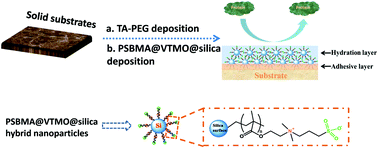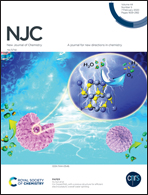Protein-resistant surface based on zwitterion-functionalized nanoparticles for marine antifouling applications†
Abstract
Here, a nanocomposite functional coating consisting of poly(sulfobetaine methacrylate)–vinyltrimethoxysilane–silica (PSBMA@VTMO@silica) hybrid nanoparticles and a combined adhesive of tannic acid (TA) and polyethylene glycol (PEG) was successfully developed through a facile deposition method, and is able to effectively block the adhesion of proteins and subsequent biofouling deposition. The PSBMA@VTMO@silica hybrid nanoparticles could endow the functional coating with high roughness, hydrophilicity and excellent abrasion-resistant properties, and the TA–PEG composite adhesive could be used as a bridge connecting the hybrid nanoparticles and the substrate to ensure the robustness and durability of the coating. Benefiting from these, the as-obtained coating not only is highly resistant to the fouling organisms but also exhibits high stability in harsh environments (for example, it maintained stable hydrophilicity for longer than 40 days in artificial seawater and still possessed good anti-adhesion of proteins after 12 sandpaper abrasion cycles). Additionally, the versatility of this approach was confirmed by successful application to other materials, such as nylon boards, polyethylene sheets and stainless steel foils. Overall, this work enriches the exploration of feasible, stable, and effective marine antifouling coatings under environmentally friendly conditions.



 Please wait while we load your content...
Please wait while we load your content...